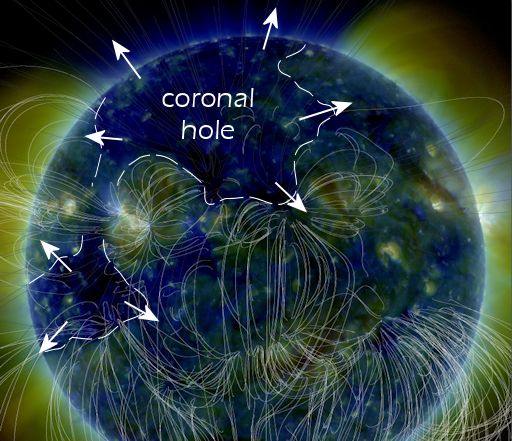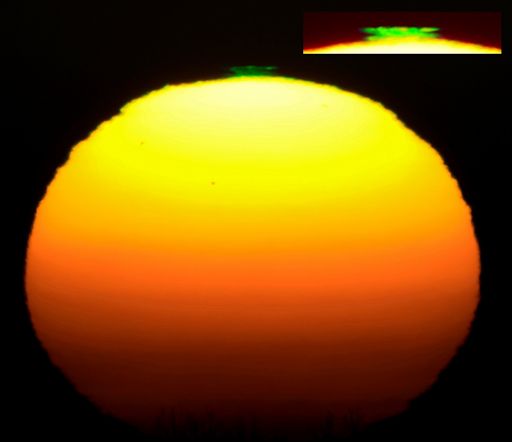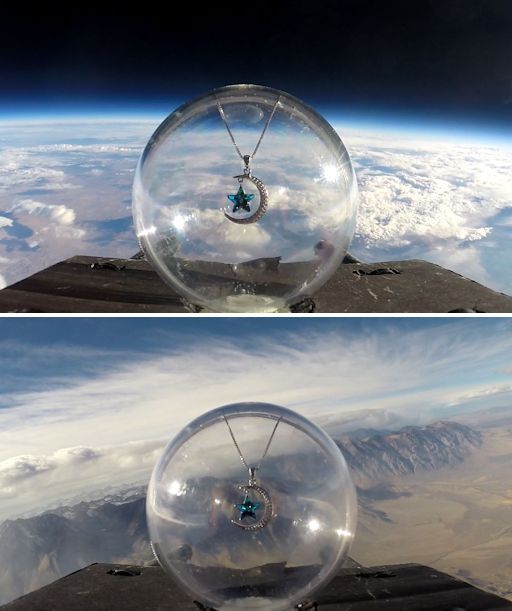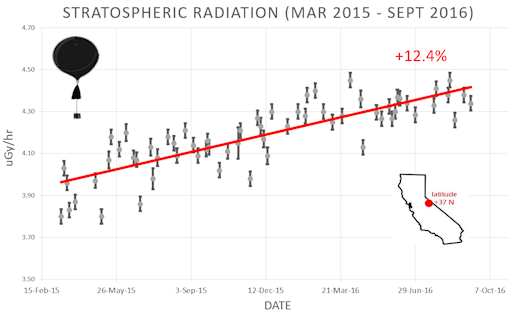Bring in the New Year with Marianne's Arctic Xpress. Spend Christmas or New Year in a remote Norwegian cabin. Chase auroras every night or join a day tour to see fjords, whales, eagles and an abundance of wildlife. Book Now | | | ARCTIC AURORA WATCH: Around the Arctic Circle, localized geomagnetic storming is possible on Dec. 17th and 18th as Earth passes through a minor stream of solar wind. This event will probably not register on NOAA storm scales because those scales measure global, not local activity. Locally, however, there could be some auroras around the poles even as the planetary K-index remains low. Free: Space Weather Alerts A BIG CORONAL HOLE TURNS TOWARD EARTH: For the third month in a row, a large hole in the sun's atmosphere is turning toward Earth. NASA's Solar Dynamics Observatory photographed the yawning structure on Dec. 16th:

This is the same coronal hole that lashed Earth's magnetosphere with solar wind on Oct. 25-28 and again on Nov. 23-26. It is spinning around with the sun, strobing Earth lighthouse-style every ~27 days. The last two times we experienced its solar wind, intermittant G1-class geomagnetic storms and bright auroras were observed in the Arctic. A repeat performance is likely when the solar wind returns on Dec. 20-22. Realtime Aurora Photo Gallery A GREEN FLASH OVER DRY LAND: Seaside photographers have a special fondness for the sunset. It's the time of day for the green flash--a split-second pulse of verdant light that signals the disappearance of the sun beneath the ocean waves. But the sea is not always required. Yesterday in Treviso, Italy, Enrico Finotto was looking across dry land when he witnessed this magnificent green flash: 
"It was a complete surprise," says Finotto.
Atmospheric optics expert Les Cowley explains what happened: "This is a mock-mirage green flash produced by light rays bending as they cross a temperature inversion layer. Such flashes can happen over land as well as the sea. We see more flashes over the sea because the sea horizon is not obscured by hills or buildings. But land flashes can be just as spectacular."
Moreover, dry land offers an advantage that the sea does not. "Over land you might also see a flash twice!" continues Cowley. "I saw once one from our garden, ran indoors and upstairs to see a repeat performance a few seconds later. Try this on a hill slope but be careful, it can be the stuff of heart attacks!" Realtime Space Weather Photo Gallery ORDER NOW FOR CHRISTMAS DELIVERY: It's out of this world: the Sirius Space Pendant. To raise money for their space weather ballooning program, the students of Earth to Sky Calculus have flown 3 dozen pendants to the edge of space–and you can have one for $79.95. The pendant comes with a greeting card showing the jewelry in flight and certifying that it has been to the stratosphere and back again. 
The pendants flew to the edge of space on Nov. 20, 2016, alongside an array of cosmic radiation sensors. During the flight, the sensors measured the highest radiation levels in the history of our monitoring program. After the balloon exploded, the payload parachuted back to Earth, landing in the snowy San Antonio mountains north of Tonopah, Nevada, where a student team recovered it on Nov. 22nd. The research of Earth to Sky Calculus is not supported by government grants or corporate donations. Instead, we are entirely crowd-funded. Proceeds from the sale of items like the Sirius Pendant go right back into cutting-edge student research. More edge of space Christmas gifts may be found in the Earth to Sky Store.
Realtime Airglow Photo Gallery
Realtime Sprite Photo Gallery Every night, a network of NASA all-sky cameras scans the skies above the United States for meteoritic fireballs. Automated software maintained by NASA's Meteoroid Environment Office calculates their orbits, velocity, penetration depth in Earth's atmosphere and many other characteristics. Daily results are presented here on Spaceweather.com. On Dec. 17, 2016, the network reported 6 fireballs.
(3 sporadics, 2 sigma Hydrids, 1 Geminid)  In this diagram of the inner solar system, all of the fireball orbits intersect at a single point--Earth. The orbits are color-coded by velocity, from slow (red) to fast (blue). [Larger image] [movies] Potentially Hazardous Asteroids ( PHAs) are space rocks larger than approximately 100m that can come closer to Earth than 0.05 AU. None of the known PHAs is on a collision course with our planet, although astronomers are finding new ones all the time. On December 17, 2016 there were 1752 potentially hazardous asteroids. Notes: LD means "Lunar Distance." 1 LD = 384,401 km, the distance between Earth and the Moon. 1 LD also equals 0.00256 AU. MAG is the visual magnitude of the asteroid on the date of closest approach. | | Cosmic Rays in the Atmosphere |
Readers, thank you for your patience while we continue to develop this new section of Spaceweather.com. We've been working to streamline our data reduction, allowing us to post results from balloon flights much more rapidly, and we have developed a new data product, shown here: 
This plot displays radiation measurements not only in the stratosphere, but also at aviation altitudes. Dose rates are expessed as multiples of sea level. For instance, we see that boarding a plane that flies at 25,000 feet exposes passengers to dose rates ~10x higher than sea level. At 40,000 feet, the multiplier is closer to 50x. These measurements are made by our usual cosmic ray payload as it passes through aviation altitudes en route to the stratosphere over California. What is this all about? Approximately once a week, Spaceweather.com and the students of Earth to Sky Calculus fly space weather balloons to the stratosphere over California. These balloons are equipped with radiation sensors that detect cosmic rays, a surprisingly "down to Earth" form of space weather. Cosmic rays can seed clouds, trigger lightning, and penetrate commercial airplanes. Furthermore, there are studies ( #1, #2, #3, #4) linking cosmic rays with cardiac arrhythmias and sudden cardiac death in the general population. Our latest measurements show that cosmic rays are intensifying, with an increase of more than 12% since 2015: 
Why are cosmic rays intensifying? The main reason is the sun. Solar storm clouds such as coronal mass ejections (CMEs) sweep aside cosmic rays when they pass by Earth. During Solar Maximum, CMEs are abundant and cosmic rays are held at bay. Now, however, the solar cycle is swinging toward Solar Minimum, allowing cosmic rays to return. Another reason could be the weakening of Earth's magnetic field, which helps protect us from deep-space radiation. The radiation sensors onboard our helium balloons detect X-rays and gamma-rays in the energy range 10 keV to 20 MeV. These energies span the range of medical X-ray machines and airport security scanners. The data points in the graph above correspond to the peak of the Reneger-Pfotzer maximum, which lies about 67,000 feet above central California. When cosmic rays crash into Earth's atmosphere, they produce a spray of secondary particles that is most intense at the entrance to the stratosphere. Physicists Eric Reneger and Georg Pfotzer discovered the maximum using balloons in the 1930s and it is what we are measuring today. | | The official U.S. government space weather bureau | | | The first place to look for information about sundogs, pillars, rainbows and related phenomena. | | | Researchers call it a "Hubble for the sun." SDO is the most advanced solar observatory ever. | | | 3D views of the sun from NASA's Solar and Terrestrial Relations Observatory | | | Realtime and archival images of the Sun from SOHO. | | | from the NOAA Space Environment Center | | | a proud supporter of science education and Spaceweather.com | | | the underlying science of space weather |  | Beautyz for top beauty products reviews and their buying guides | | | These links help Spaceweather.com stay online. Thank you to our supporters! | | 
